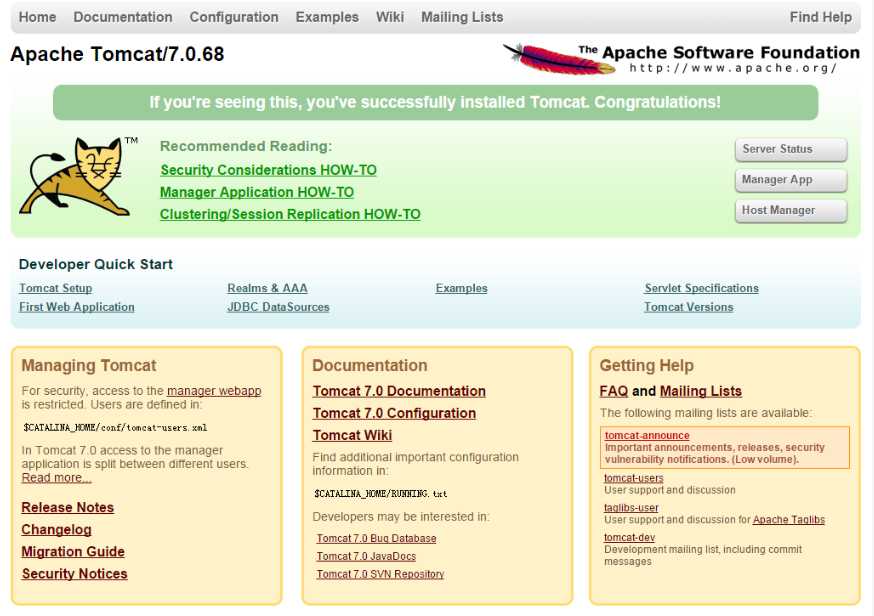公司新项目要在linux下部署,搭建一下java运行环境,记录一下。
一、安装mysql
1去官网下载mysql,下载后并解压,我把mysql安装在/usr/local/mysql路径下
tar -zxvf mysql-5.7.11-linux-glibc2.5-x86_64.tar.gz -C /usr/local/mysql
2进入mysql目录,建立data文件夹
[root@localhost local]# cd /usr/local/mysql [root@localhost mysql]# mkdir data
3新建不能登陆的mysql用户
useradd -r -M -s /sbin/nologin mysql
4修改mysql目录所有者为mysql用户和mysql组
chown -R mysql.mysql /usr/local/mysql chgrp -R mysql /usr/local/mysql
5进入/usr/local/mysql目录,初始化mysql,后面那个是初始密码,要记住
bin/mysqld --initialize --user=mysql --basedir=/usr/local/mysql --datadir=/usr/local/mysql/data

6复制my.cnf文件,并修改/etc/my.cnf
cp /usr/local/mysql/support-files/my-default.cnf /etc/my.cnf
# These are commonly set, remove the # and set as required. basedir = /usr/local/mysql datadir = /usr/local/mysql/data port = 3306 character-set-server=utf8 collation-server=utf8_general_ci default-storage-engine=INNODB #server_id = ..... # socket = .....
7进行mysql.support-files目录,复制mysql.server到/etc/init.d/mysqld,加入开机运行
[root@localhost mysql]# cd support-files/
[root@localhost support-files]# cp mysql.server /etc/init.d/mysqld
[root@localhost support-files]# chmod +x /etc/init.d/mysqld
[root@localhost support-files]# chkconfig --add mysqld
查看是否成功
chkconfig --list mysqld

8mysql加入环境变量
vi /etc/profile #把mysql服务加入系统环境变量:在最后添加下面这一行 export PATH=$PATH:/usr/local/mysql/bin :wq! #保存退出 source /etc/profile #使配置立刻生效
9登录后修改密码
[root@localhost tmp]# service mysqld start Starting MySQL. SUCCESS! [root@localhost tmp]# mysql -uroot -p Enter password: mysql> SET PASSWORD = PASSWORD(‘123456‘); mysql> flush privileges;
二jdk安装
1下载jdk,解压并移动到安装路径
tar -zxvfjdk-8u73-linux-x64.tar.gz -C /usr/local/jdk8
2加入环境变量
vi /etc/profile # 在export PATH USER LOGNAME MAIL HOSTNAME HISTSIZE HISTCONTROL下添加 export JAVA_HOME=/usr/local/jdk8 export PATH=$JAVA_HOME/bin:$PATH export CLASSPATH=.:$JAVA_HOME/lib/dt.jar:$JAVA_HOME/lib/tools.jar
#保存后,执行source /etc/profile使其生效
3验证是否成功java -vsersion
三安装tomcat
1解压并安装到指定路径
1 2 3 4 5 6 7 8 9 10 11 12 13 14 15 | # 创建用户groupadd tomcatuseradd -s /bin/bash -g tomcat tomcat# 下载:wget http://apache.opencas.org/tomcat/tomcat-7/v7.0.68/bin/apache-tomcat-7.0.68.tar.gz# 解压:tar -zxvf apache-tomcat-7.0.68.tar.gz# 复制:cp -R ./apache-tomcat-7.0.68 /usr/localcd /usr/local/apache-tomcat-7.0.68# 修改权限:chown -R tomcat:tomcat apache-tomcat-7.0.68# 启动:sh ./bin/startup.sh |
2将8080端口添加到防火墙例外并重启
1 2 | firewall-cmd --zone=public --add-port=8080/tcp --permanentfirewall-cmd --reload |
3访问http://ip/8080

四安装nginx
安装nginx前,前提是安装了gcc-c++,还要安装一些依赖库
1安装perl
mkdir /usr/local/perl cd perl5.22 ./Configure -des -Dprefix=/usr/local/ perl -Dusethreads -Uversiononly make make test make install
2安装pcre
mkdir /usr/local/pcre tar zxvf pcre-8.35.tar.gz cd pcre-8.35 ./configure --prefix=/usr/local/pcre make make install
3安装openssl
mkdir /usr/local/openssl tar zxvf openssl-1.0.1h.tar.gz cd openssl-1.0.1h ./config --prefix=/usr/local/openssl make make install vi /etc/profile export PATH=$PATH:/usr/local/openssl/bin :wq! source /etc/profile
4安装zlib
mkdir /usr/local/zlib tar zxvf zlib-1.2.8.tar.gz cd zlib-1.2.8 ./configure --prefix=/usr/local/lib/zlib make make install
5安装nginx
#添加用户和用户级 groupadd nginx useradd -g nginx nginx -s /bin/false mkdir /usr/local/nginx tar zxvf nginx-1.6.0.tar.gz cd nginx-1.6.0 ./configure --prefix=/usr/local/nginx --without-http_memcached_module --user=nginx --group=nginx --with-http_stub_status_module --with-http_ssl_module --with-http_gzip_static_module --with-openssl=/root/tool/openssl-1.0.2g/ --with-zlib=/root/tool/zlib-1.2.8/ --with-pcre=/root/tool/pcre-8.37 #注意:--with-openssl=/usr/local/src/openssl-1.0.1h --with-zlib=/usr/local/src/zlib-1.2.8 --with-pcre=/usr/local/src/pcre-8.35指向的是源码包解压的路径,而不是安装的路径,否则会报错 make make install
6
#添加80端口到防火墙 firewall-cmd --zone=public --add-port=80/tcp --permanent firewall-cmd --reload #启动nginx /usr/local/nginx/sbin/nginx
nginx -s reload :修改配置后重新加载生效
nginx -s reopen :重新打开日志文件
nginx -t -c /path/to/nginx.conf 测试nginx配置文件是否正确
关闭nginx:
nginx -s stop :快速停止nginx
quit :完整有序的停止nginx
其他的停止nginx 方式:
ps -ef | grep nginx
kill -QUIT 主进程号 :从容停止Nginx
kill -TERM 主进程号 :快速停止Nginx
pkill -9 nginx :强制停止Nginx
启动nginx:
nginx -c /path/to/nginx.conf
平滑重启nginx:
kill -HUP 主进程号
7设置nginx开机启动
vi /etc/init.d/nginxd #编辑启动文件添加下面内容 #!/bin/bash # #chkconfig: - 85 15 #description: Nginx is a World Wide Web server. #processname: nginx nginx=/usr/local/nginx/sbin/nginx conf=/usr/local/nginx/conf/nginx.conf case $1 in start) echo -n "Starting Nginx" $nginx -c $conf echo " done" ;; stop) echo -n "Stopping Nginx" killall -9 nginx echo " done" ;; test) $nginx -t -c $conf ;; reload) echo -n "Reloading Nginx" ps auxww | grep nginx | grep master | awk ‘{print $2}‘ | xargs kill -HUP echo " done" ;; restart) $0 stop $0 start ;; show) ps -aux|grep nginx ;; *) echo -n "Usage: $0 {start|restart|reload|stop|test|show}" ;; esac :wq! #保存退出 注意(centos7没有killall命令,要先安装,yum install psmisc) chmod +x /etc/init.d/nginxd #赋予文件执行权限 chkconfig --add nginxd#添加到服务 chkconfig nginxd on #设置开机启动 /etc/init.d/nginxd restart #重启
8nginx和tomcat整合,修改nginx配置文件
server { listen 80; server_name localhost; index index.html index.htm index.jsp;#设定访问的默认首页地址 root /home/www/web/ROOT;#设定网站的资源存放路径 #limit_conn crawler 20; location / { index index.html index.jsp; } location ~ .*.jsp$ #所有jsp的页面均交由tomcat处理 { index index.jsp; proxy_pass http://192.168.222.128:8080;#转向tomcat处理 } location ~ .*\.(gif|jpg|jpeg|png|bmp|swf)$ #设定访问静态文件直接读取不经过tomcat { expires 30d; } location ~ .*\.(js|css)?$ { expires 1h; } #定义访问日志的写入格式 #log_format access ‘$remote_addr - $remote_user [$time_local] "$request" ‘ #‘$status $body_bytes_sent "$http_referer" ‘ #‘"$http_user_agent" $http_x_forwarded_for‘; #access_log /usr/local/nginx/logs/localhost.log access;#设定访问日志的存放路径 }

